Game Zone: Osmos
by Ryan Smith (Xyus)

Perhaps the only thing most of us will remember from our middle school physics classes, Newton's third law of motion is apparent in everything on the macro-scale, from the launch of a rocket, to the friction that keeps you from sliding around when you walk down the street. This law (as well as conservation of mass) is also the principle behind Osmos, a unique commercial ambient puzzle game where you eject mass and devour other little single-celled organisms to solve a variety of puzzles.
Osmos was developed and published by Hemisphere Games, a new independent game company with some interesting credentials. The lead developers Eddy Boxerman and Dave Burke have worked as developers on the Splinter Cell (Boxerman), Gears of War, and Unreal Tournament franchises (Burke), and Burke also worked as a developer on the Unreal Engine 3, the engine behind such blockbusters as BioShock, Gears of War, and Army of Two. The others that have worked on Osmos have equally wonderful credentials. They obviously have the experience to make a great FPS. But how does that translate into their ambient physics-puzzle game? Pretty well in my opinion (and in others [1][2]) despite the fact that it isn't anything like the games they are "used to".
Game Play
Now, back to the subject at hand. The idea of the game is simple. You are a "mote", a single celled organism whose only goal in life is to become the largest in the pool by absorbing other motes, or to absorb a specific particularly delicious looking mote. This is often more difficult than it sounds, as you must avoid all larger motes, gravity projecting "Attractor" motes, and the particularly hostile "Sentient" motes, while at the same time competing with them for smaller motes.
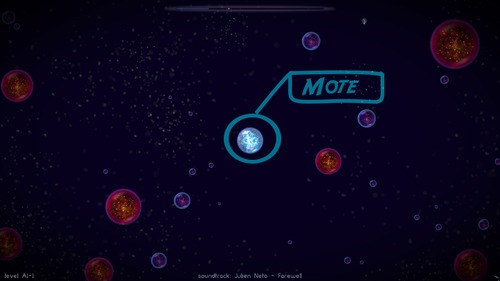
Levels are categorized into three different types, or "Zones" - the "Ambient", "Sentient", and "Force" zones - each with different styles of play. For each zone there is also several variations with their own challenges. The player may choose to play a random variation of any level in the game.
In all zones, you move around the level by clicking (or holding) the left mouse button in the opposite direction you wish to move. Your mote will eject mass in the direction that you clicked, pushing you forward but making you smaller at the same time. If you touch a mote that is smaller than you, you will absorb it and gain mass, and if you touch a mote that is larger, it'll absorb you (with one exception - Antimatter Motes will absorb other motes whether they are smaller or not. Avoid!) Ejected masses are motes in their own right, able to absorb or be absorbed by other motes.
In ambient zones, the goal is simple: become the largest mote. To achieve that goal, you must wade around in large pool of inactive (Non-sentient) motes, absorb other motes, and avoid large motes. While the basic ambient zone level may be simple and relatively easy, the variants of it can be anything but. For example, a common variant places you in a pool full of very fast moving, large motes. Now, not only do you have to seek out smaller motes while avoiding larger ones - which is the standard goal, you also have to do this while they are racing around at speeds that are possibly faster than yours, not to mention that the average mote is now larger than usual.
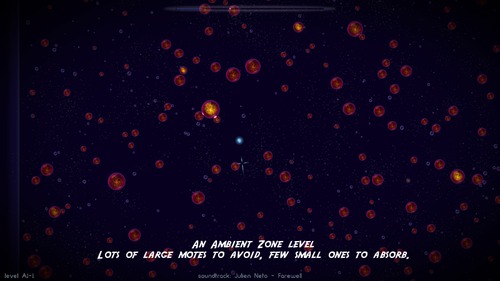
In sentient zones, your goal is to chase down and absorb a particularly intelligent mote. This mote will target other motes, pursue them, and then absorb them, gaining mass and becoming even more difficult to absorb. When you get close to a sentient mote, it will behave differently, depending on what type of sentient it is. For example, the biophobe will run in terror as you approach if you are larger but not bother you while you are small, while more aggressive types will chase you until you run out of mass to eject.
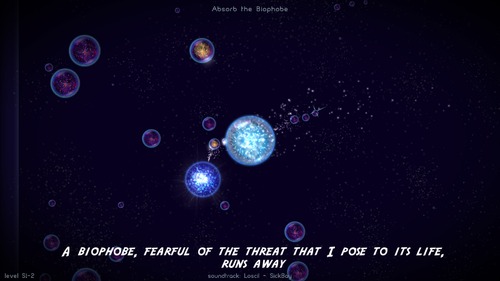
In force zones, a two new types of mote are introduced, the "Attractor", which projects a gravity- like force around itself that draws other motes toward it, and the "Repulsor", which pushes other motes away with an anti-gravity-like force. This zone always has similar goals as the ambient or sentient zones, but throws in one critical new game dynamic - players must now factor in orbital dynamics, or risk being absorbed by the attractor or wasting mass with bad movements. Don't worry, pressing "Alt+O" will project your orbit onto the screen, helping you with these levels. Variants include levels with attractors orbiting other attractors or attractors repelling each other and bouncing randomly around the pool (which can be quite chaotic).
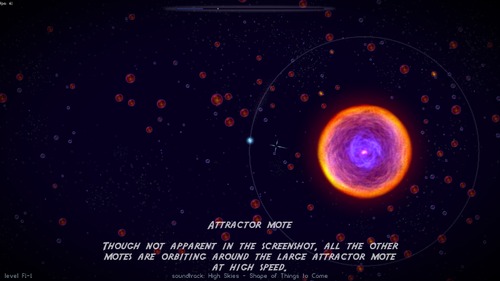
Availability
Osmos is available for Linux, Mac and Windows (and a version of it exists for the iPad). The full version includes 47 levels ranging from serene to challenging, many different types of motes, and the ability to play random variations of any level.
Osmos is a commercial game, and can be purchased directly at Hemisphere Games' Website through PayPal for $10 (US). Direct purchase includes all three versions, and is DRM free.
System Requirements
Minimum Recommended:
Processor: 1 GHz
Memory: 512 MB RAM
Graphics: 3D graphics card with OpenGL support.
Minimum resolution 800x600
Hard Drive: 33 Mb
Library Requirements:
OpenAL
Freetype
libvorbis and libogg
(Make sure you have the most recent version of
each!)
Unfortunately, I couldn't find hardware requirements on the official website (or their forum, or in the read-me from the download), so I took the hardware requirements from the Steam website (The steam version is for Windows, so these may not be entirely accurate for Linux. But it shouldn't be off by too much).
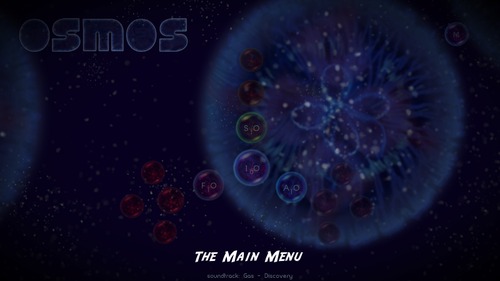
Hints and Tips
The game play is quite simple, and you'll pretty much know exactly what to do in each level. Anything I could tell you could easily be figured out while playing the game. That's not to say I won't give you some general tips though, just so you can 'go in knowing them':
- Be careful about how much mass you eject. You can easily deplete your reserves by holding the left mouse button down, and it is really easy to use more than necessary even when you aren't holding the button down. While you can get away with this in early levels, this will haunt you in the later ones.
- After the first couple of levels, you can speed up the game by clicking the middle mouse button and slow it down by clicking the right mouse button. Use this to your advantage.
- While this is not really a game play tip or hint, If you are finding later levels hard and/or frustrating, go back to the earlier levels and/or levels in the Ambient Zone. They are excellent for relaxing. The music helps.
Conclusion/My Thoughts
Osmos is an interesting and fun game. The music is superb - possibly the best I have heard in the puzzle/ambient genres - and the dream like artwork adds greatly to the character of the game. I believe that it is certainly worth the $10, and that it has the potential to keep you playing once in a while long after you initially purchase it (anyone who has played Tetris will know this particular kind of "keep you playing" feeling).
However, that brings me to my final point: I believe it is worth $10. Not everyone will. This game is of a very specific type, and if you have played similar games before, but didn't like them, then this game probably won't have a different effect on you. For those of you who are interested, grab the Demo (middle of the page), and see if it would be something you'd find fun.
